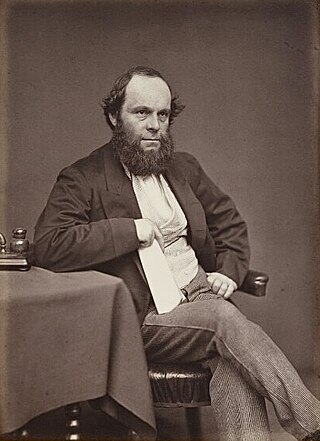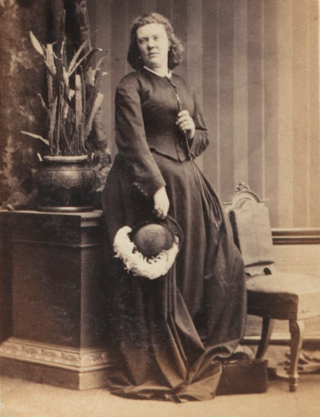Related Research Articles
Duke of Buckingham, referring to Buckingham, is an extinct title that has been created several times in the peerages of England, Great Britain, and the United Kingdom. There were creations of double dukedoms of Buckingham and Normanby and of Buckingham and Chandos. The last holder of the dukedom died in 1889.

Michael Edward Abney-Hastings, 14th Earl of Loudoun, was a British-Australian farmer, who is most noted because of the 2004 documentary Britain's Real Monarch, which alleged he was the rightful monarch of England instead of Queen Elizabeth II. From February 1960 until November 2002, he held the courtesy title Lord Mauchline.

Viscount Cobham is a title in the Peerage of Great Britain that was created in 1718. Owing to its special remainder, the title has passed through several families. Since 1889, it has been held by members of the Lyttelton family.

Earl of Huntingdon is a title which has been created several times in the Peerage of England. The medieval title was associated with the ruling house of Scotland.

Baron Hastings is a title that has been created three times. The first creation was in the Peerage of England in 1290, and is extant. The second creation was in the Peerage of England in 1299, and became extinct on the death of the first holder in c. 1314. The third creation was in the Peerage of England in 1461, and has been in abeyance since 1960.

Lord Kinloss is a title in the Peerage of Scotland. It was created in 1602 for Edward Bruce, later Master of the Rolls, with remainder to his heirs and assigns whatsoever. In 1604 he was also made Lord Bruce of Kinloss, with remainder to his heirs male, and in 1608 Lord Bruce of Kinloss, with remainder to any of his heirs. He was succeeded by his son, the second Lord, who was killed in a duel in 1613.

Earl Temple of Stowe, in the County of Buckingham, is a title in the Peerage of the United Kingdom. It was created in 1822 for Richard Temple-Nugent-Brydges-Chandos-Grenville, 2nd Marquess of Buckingham, who was created Marquess of Chandos and Duke of Buckingham and Chandos at the same time. In contrast to the Marquessate and Dukedom, which were created with remainder to the heirs male of his body only, the Earldom was created with remainder to (1) the heirs male of his body, failing which to (2) the heirs male of his deceased great-grandmother the 1st Countess Temple, failing which to (3) his granddaughter Lady Anna Grenville and the heirs male of her body, and then to possible younger daughters of Lord Temple and the heirs male of their bodies.

Baron Hungerford is a title in the Peerage of England. It was created on 7 January 1426 for Walter Hungerford, who was summoned to parliament, had been Member of Parliament, Speaker of the House and invested as Knight of the Order of the Garter before and was made Lord High Treasurer one year before he became a peer. The man who would later succeed as third baron was created Baron de Moleyns on 13 January 1445 by writ of summons; both titles merged when he succeeded as Baron Hungerford in 1459. The third baron was attainted and the peerage forfeit in 1461. This attainder was reversed in 1485 for the then 4th baroness of Hungerford, and so it came into the Hastings family of Earls of Huntingdon until 1789, when it came into the Rawdon(-Hastings) family of the Marquesses of Hastings until 1868 when it fell into abeyance. This abeyance was terminated three years later for a member of the Abney-Hastings family and an Earl of Loudoun. In 1920 it again fell into abeyance, which was terminated one year later for the Philipps family of the Viscounts of St Davids where it has remained since.

Richard Plantagenet Campbell Temple-Nugent-Brydges-Chandos-Grenville, 3rd Duke of Buckingham and Chandos,, styled Earl Temple until 1839 and Marquess of Chandos from 1839 to 1861, was a British soldier, politician and administrator of the 19th century. He was a close friend and subordinate of Benjamin Disraeli and served as the secretary of state for the colonies from 1867 to 1868 and governor of Madras from 1875 to 1880.

Henry Hastings, 3rd Earl of Huntingdon, KG, KB was an English Puritan nobleman. Educated alongside the future Edward VI, he was briefly imprisoned by Mary I, and later considered by some as a potential successor to Elizabeth I. He hotly opposed the scheme to marry Mary, Queen of Scots, to the Duke of Norfolk, and was entrusted by Elizabeth to see that the Scottish queen did not escape at the time of the threatened uprising in 1569. He served as President of the Council of the North from 1572 until his death in 1595.

Richard Plantagenet Temple-Nugent-Brydges-Chandos-Grenville, 2nd Duke of Buckingham and Chandos,, styled Viscount Cobham from birth until 1813, Earl Temple between 1813 and 1822 and Marquess of Chandos between 1822 and 1839, was a British Tory politician. He served as Lord Privy Seal between 1841 and 1842.

Edith Maud Rawdon-Hastings, 10th Countess of Loudoun was a Scottish peer. She died aged 40 after caring for Rowallan Castle. Sir George Gilbert Scott designed an Eleanor Cross style monument to her which was erected in Ashby de la Zouch.
Baron Donington, of Donington Park in the County of Leicester, was a title in the Peerage of the United Kingdom. It was created on 4 May 1880 for Charles Frederick Abney-Hastings. Born Charles Frederick Clifton, he was the widower of Edith Mary Abney-Hastings, 10th Countess of Loudoun. He and his wife had in 1859 assumed by Royal licence the surname of Abney-Hastings on succeeding to the Abney-Hastings estates after the death of his wife's kinsman Sir Charles Abney-Hastings, 2nd Baronet in 1858. They were both succeeded by their eldest son Charles Edward Rawdon-Hastings, 11th Earl of Loudoun and 2nd Baron Donington. However, on his death in 1920 the titles separated. The Scottish earldom was inherited by his niece Edith, daughter of his second brother the Hon. Major Paulyn Francis Cuthbert Rawdon-Hastings. The barony of Donington, which could only be inherited by male heirs, passed to his third brother Gilbert Theophilus, who became the third Baron. He had four daughters but no sons, and on his death in 1927 the barony became extinct.

Lady Anne Hastings, Countess of Huntingdon was an English noble. She was the daughter of Henry Stafford, 2nd Duke of Buckingham, and Catherine Woodville, sister of queen consort Elizabeth Woodville. She was first the wife of Sir Walter Herbert and then George Hastings, 1st Earl of Huntingdon, and served in the household of King Henry VIII's daughter, the future Queen Mary I.

Francis Hastings, 2nd Earl of Huntingdon, KG was the eldest son of George Hastings, 1st Earl of Huntingdon and Anne Stafford, Countess of Huntingdon, the ex-mistress of Henry VIII.

James Brydges, 3rd Duke of Chandos PC, styled Viscount Wilton from birth until 1744 and Marquess of Carnarvon from 1744 to 1771, was a British peer and politician.
Francis Hastings, Lord Hastings was the son of George Hastings, 4th Earl of Huntingdon and Dorothy Port. He married Sarah Harington, daughter of Sir James Harington and Lucy Sydney. They had five children:

Charles Bruce, 3rd Earl of Ailesburyand 4th Earl of Elgin, of Ampthill, Bedfordshire and Savernake Park, Wiltshire, styled Viscount Bruce of Ampthill from 1685 to 1741, was a British landowner and Tory politician who sat in the English and British House of Commons from 1705 until 1711 when he was raised to the peerage as one of Harley's Dozen and sat in the House of Lords.
Charles Edward Rawdon-Hastings, 11th Earl of Loudoun was a Scottish peer.
Teresa Mary Nugent Freeman-Grenville, 13th Lady Kinloss is a Scottish peer.
References
- ↑ Lehman, H. E. (2005). Lives of England's Monarchs: The Story of Our American English Heritage . AuthorHouse. p. 176. ISBN 978-1-4184-9692-0.
was roger mortimer.
- ↑ "Edward IV, king of England". The Penny Cyclopedia. Vol. IX: Dionysius–Erne. 1837. p. 294.
- ↑ Willis, Browne (1755). The History and Antiquities of the Town, Hundred, and Deanry of Buckingham: Containing a Description of the Towns, Villages, Hamlets, Monasteries, Churches ... etc. p. 328.
- ↑ Sargeant, Carol (December 2011). Love, Honour and Royal Blood: Book Three: Rose Red, Royal Blue Lancaster. Dog Ear Publishing. p. 229. ISBN 978-1-4575-0763-2.
- ↑ "Britain's Real Monarch". Channel4 . 2004. Archived from the original on 22 May 2016. Retrieved 27 May 2016.
- ↑ Rowse, A. L. (1966). Bosworth Field and the Wars of the Roses. Macmillan. p. 166.
- ↑ Reitwiesner, William Addams. "Descendants of Anne, Countess of Castlehaven". wargs.com. Retrieved 27 May 2016.
- ↑ Reitwiesner, William Addams. "The Henrician succession to the Throne of England". wargs.com. Retrieved 27 May 2016.
- ↑ "Obituary: Lady Kinloss". The Daily Telegraph . London, UK. 30 October 2012. Retrieved 27 May 2016.
- ↑ "Lady Kinloss was Tudor claimant to the throne". Vancouver Sun . 2012.
- ↑ "Lady Kinloss". The Herald . Glasgow. 2012. Retrieved 27 May 2016.
- ↑ Aronson, Theo (1979). Kings Over the Water. London: Cassell. p. 229.
- ↑ The Jacobite claim is to the thrones held and claimed by James II and VII; as king of England, Scotland, France (claimed by English monarchs since the Hundred Years' War), and Ireland. The Acts of Union that created Great Britain and the United Kingdom are considered invalid by those who believe that the monarchs who gave the Acts the Royal Assent were not the legitimate occupants of the throne. Cf. The Legitimist Kalendar for the Year of Our Lord 1895 (London: Henry, 1895), p.22.